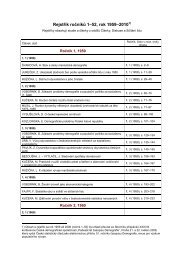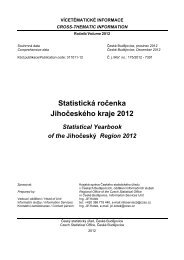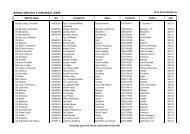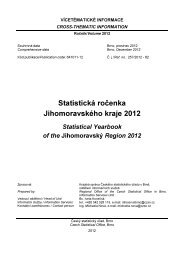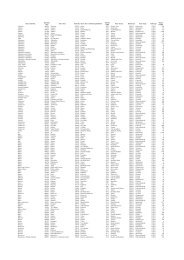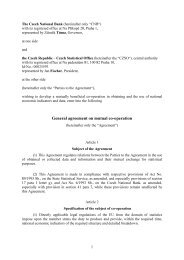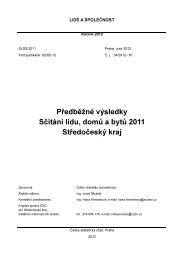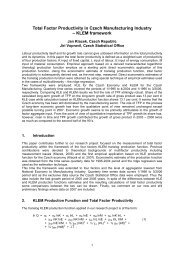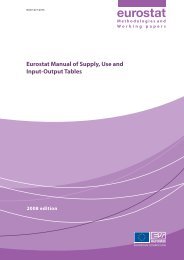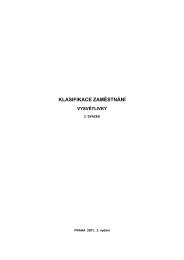22CHARACTERISTICS OF THE REGIONThe Ústecký Region lies in the northwest of the Czech Republic along its northern border with the FederalRepublic of Germany, particularly with the Free State of Saxony. The Region’s neighbours are also theLiberecký Region in the northeast, the Karlovarský and partly the Plzeňský Regions in the west, and theStředočeský Region in the southeast.Surface of the Region is very diverse from the point of view of geography; the nature is varied and manifold.Along the borders with Germany the area is surrounded by the Ore Mountains (Krušné hory), the SandstoneRocks of Labe (or Labské pískovce) and the Lužice Mountains. The Ore Mountains are very old; they areformed of volcanic rocks or Palaeozoic schist. The south-eastern part of the Region consists of plains thatoriginate from Mesozoic era – the so-called Česká křídová tabule (Czech Cretaceous Formation) – fromwhich the mountain “Říp” rises (it is associated with the famous legend of our ancestors coming to Bohemia)and also the České Středohoří (the Bohemian Low Mountain Range) with its highest peak Milešovka. TheČeské Středohoří originated from a volcanic activity in the Tertiary era and has a unique face of thelandscape with many contrasts and picturesque secluded spots. The highest point on the territory of theRegion lies on the hillside of the highest peak of the Ore Mountains – Klínovec – the top of which is locatedalready on the territory of the Karlovarský Region. Not taking into account bottoms of surface mines thelowest point of the Region is the surface of the Labe (Elbe) River at Hřensko (115 m above sea level), whichis at the same time the lowest point of the Czech Republic. The Labe River is the largest watercourse on theterritory of the Region; from the left the second biggest tributary – Ohře – and also the Bílina River flow to it.From the right the Ploučnice River flows to Labe; the last tributary from the right on our territory is theKamenice River. Also mineral and thermal springs can be found in the Region. The biggest water area is theNechranická reservoir built on the Ohře River in the western part of the Region.The area of the Region 5,335 square kilometres accounts for 6.8% of the Czech Republic’s total area.Agricultural land covers nearly 52% of the Region’s territory, forests cover 30% and water areas 2% of theterritory.The Ústecký Region is varied as for natural conditions as well as from the point of view of its economicstructure, density of settlement and condition of the environment. Historically, economic importance of theRegion is based on its raw materials, especially large deposits of brown coal, which lie close to the surface.The brown coal basin stretches under the hillsides of the Ore Mountains from the town of Ústí nad Labem toKadaň. There are also other important raw materials in the Region, e.g. quality glass and foundry sands andbuilding stone. Four distinct areas can be defined in the Region that differ much one from another. It is anarea with highly developed industrial production, which is concentrated preliminary in the foothills of the OreMountains (the Chomutov, Most, Teplice and partially also Ústí nad Labem District). Among branches, animportant position belongs to the energy industry, coal mining, mechanical engineering, and chemical andglass industry. Other important areas are around Litoměřice and Louny, which are known for their productionof hops and vegetables. Especially, the areas along the Labe River and Ohře River are well-known fruitgrowing regions (the so-called Garden of Bohemia). Grapes grown in the Litoměřice area have excellentreputation. During recent years, the area around Most has become a known wine-growing region, in whichvine is grown mainly on lands that were reclaimed after brown coal mining. The Ore Mountains area is amountain range with sparse population and limited economic activities and the area around Děčín is neitheran area with concentration of heavy industry nor an agricultural area. Its northern part called Šluknovsko is atypically peripheral territory with its remoteness and difficult accessibility from central parts of the Region.The Ústecký Region breaks up into seven administrative districts (Děčín, Chomutov, Litoměřice, Louny,Most, Teplice and Ústí nad Labem) comprising 354 municipalities of various sizes, of which 58 have a statusof town. As at 1 January 2003 the second phase of the state administration reform came into force, whichdeterminated in a decree administrative districts of municipalities with extended competence andadministrative districts of municipalities with commissioned local authority including their seats. From thatdate 16 administrative districts of municipalities with extended competence originated in the Ústecký Region:Bílina, Děčín, Chomutov, Kadaň, Litoměřice, Litvínov, Louny, Lovosice, Most, Podbořany, Roudnice nadLabem, Rumburk, Teplice, Ústí nad Labem, Varnsdorf, and Žatec and also 30 administrative districts ofmunicipalities with commissioned local authority.As at the end of 2011, the Ústecký Region had 828,026 inhabitants and thus it ranks fifth in the CzechRepublic. Population density (155 inhabitants per square kilometre) is higher than the national average (133per sq km) and the Region is the fourth densest area after the City of Prague, the Moravskoslezský Regionand the Jihomoravský Region. The densest settlement is in the brown coal basin under the Ore Mountains,lower density is in the area of the Ore Mountains and the Louny District and Litoměřice District, in whichpredominantly smaller country seats are placed. The largest municipality and at the same time the seat ofthe Region is the town of Ústí nad Labem with 94,258 inhabitants. What is characteristic for the Region is itsrelatively young population; the average age is 40.4 years, The Ústecký Region ranks fourth in the numberStatistická ročenka Ústeckého <strong>kraje</strong> <strong>2012</strong>
of live births per 1,000 inhabitants (10.4) but there is one of highest mortality in the Czech Republic (10.7deaths per 1,000 inhabitants). The Ústecký Region ranks third in the number of divorces per 1,000inhabitants (2.8) and first in the number of abortions per 100 live births (46.8).In 2011, the Region’s gross domestic product accounted for 6.3% of the CR’s GDP; converted to GDP perinhabitant it amounts to 80% of the national average and ranks tenth in the CR. Among the most importantemployers of the Ústecký Region are: Mostecká uhelná společnost, Severočeské doly (coal miningcompanies), Chemopetrol (petrochemical company), and Krajská zdravotní, a.s. (Regional Health, Inc.) Ústínad Labem, which has associated Hospital Děčín, Masaryk´s hospital in Ústí nad Labem, Hospital Teplice,Hospital Most and Hospital Chomutov since 2007.Industrial activity from the past had and still has an unfavourable influence on the quality of the environment.Strongly developed surface mining distinctively damaged the natural face of the landscape, which graduallyrecovers only thanks to a costly recultivation. Well-known are also problems with the emission situation in theRegion. During the last decade it has much improved (it can be proved by a decreasing amount ofemissions), however, the Region is still perceived as an area with the most damaged environment. Aninglorious primacy belongs to the Region as for the specific emissions of sulphur dioxide (t/km 2 ), andnitrogen oxides.Part of the territory of the Region is covered by the České Švýcarsko (Czech Switzerland) national park withthe area of 7,900 hectares that was founded in 2000 and also by the following protected landscape areas:České Středohoří (the Bohemian Midlands), the Labské pískovce (the Sandstone Rocks of Labe),Kokořínsko and the Lužice Mountains. One can find 142 small-area protected landscape areas that coverthe area of 3,979 hectares.From the labour force sample survey it results that there are about 366,6 thousand employed persons in theRegion of which most work in the processing industry (about 98,8 thousand by classification CZ-NACE ). In2011, the average gross monthly wage in the Region reached 22,161 CZK (FTE), which is by 2,158 CZKless than the national average and the Region ranks seventh among all the regions in the CR. Decrease ofcoal mining, restructuring of enterprises, slowing down of productions and agriculture cause that in thenational comparison the Ústecký Region has in the long-term the highest registered unemployment rate(12.94%, in the CR 8.62% as at 31 December 2011).In the statistical Business Register, more than 178 thousand enterprises, organisations and entrepreneurswere registered in the end of 2011. The biggest part comprised of entrepreneurs – natural persons notincorporated in the Companies Register (more than 128 thousand). From the point of view of the CZ-NACEclassification most entities dealt with wholesale and retail trade, repair of motor vehicles, motorcycles andpersonal and household goods.The network of educational establishments comprises 330 nursery schools, 281 basic schools, 104secondary technical schools and grammar schools. One universities provide university education in Ústí nadLabem it is Purkyně University.The network of outpatient care establishments and pharmacies provides basic health care in the Region.Urgent medical care is provided in 20 hospitals with 5,108 beds. The most important health careestablishment in the Region is and Krajská zdravotní, a.s. Ústí nad Labem which has associated Hospital´sDěčín, Ústí nad Labem, Teplice, Most and Chomutov. Following and rehabilitation care is ensured in 13specialised therapeutic institutions with 1,281 beds, of which 6 institutions are determined for long-termpatients.The Region has an important transport location in relation to the European Union. The importantinternational road E55 runs through the Teplice and Litoměřice Districts, linking the north and south ofEurope, and going on from the town of Lovosice as the highway D8. At the end of 2006 a new segment ofhighway D8 over Krušné hory with direct connection to the German highway A17 was open to traffic. Anotherimportant route is the road leading along Krušné hory (the Ore Mountains) to the northern part of theLiberecký Region. No less important is also the route coming from the Federal Republic of Germany viaChomutov and Louny to Prague. The main railway route is the international track from the Federal Republicof Germany via the town of Ústí nad Labem to Prague. The Labe River is the most important water route inthe Czech Republic and enables shipping to Hamburg, a port in the North Sea.There are several border crossings in the Region: 13 road border crossings, 3 railway border crossings,1 river border crossing and many newly built crossings for pedestrians and cyclists.Due to its rich history of settlement, the Ústecký Region boasts of a great number of historic buildings andmonuments. The best known is, for example, Romanesque rotunda on the Říp Mountain, Gothic church inMost, baroque castle in Duchcov, monastery in Osek and Doksany and chateaux Ploskovice andLibochovice. Litoměřice, Úštěk and Terezín were designated urban conservation areas and centre ofStatistická ročenka Ústeckého <strong>kraje</strong> <strong>2012</strong> 23
- Page 1 and 2: VÍCETÉMATICKÉ INFORMACECROSS-THE
- Page 3 and 4: PŘEDMLUVAStatistická ročenka Ús
- Page 5 and 6: FOREWORDThe Statistical Yearbook of
- Page 7 and 8: OBSAHPředmluva....................
- Page 9 and 10: 27-11. Výsledky sčítání lidu,
- Page 11 and 12: 16-106. Kapacita hromadných ubytov
- Page 13 and 14: 11-3. Harvest of crops.............
- Page 15 and 16: LIST OF MAPS AND GRAPHSGeographical
- Page 17 and 18: 16-105. Capacity of collective tour
- Page 19 and 20: Statistická ročenka Ústeckého k
- Page 21: Chemopetrol a Krajská zdravotní,
- Page 25 and 26: TABULKOVÁ ČÁSTStatistická roče
- Page 27 and 28: ZÁKLADNÍ CHARAKTERISTIKABASIC CHA
- Page 29 and 30: BASIC CHARACTERISTIC1-2. Long-term
- Page 31 and 32: 2006 2007 2008 2009 2010 2011 UnitB
- Page 33 and 34: 2006 2007 2008 2009 2010 2011 UnitB
- Page 35 and 36: 2006 2007 2008 2009 2010 2011 UnitB
- Page 37 and 38: OKRESYDISTRICTS1-4. Vybrané ukazat
- Page 39 and 40: OKRESYDISTRICTS1-6. Vybrané ukazat
- Page 41 and 42: OKRESYDISTRICTS1-8. Vybrané ukazat
- Page 43 and 44: Porovnání vybraných ukazatelů v
- Page 45 and 46: ÚZEMÍAREA2-1. Vybrané údaje o
- Page 47 and 48: ÚZEMÍAREA2-4. Velikostní skupiny
- Page 49 and 50: ŽIVOTNÍ PROSTŘEDÍ3-1. Chráněn
- Page 51 and 52: ŽIVOTNÍ PROSTŘEDÍENVIRONMENT3-3
- Page 53 and 54: ŽIVOTNÍ PROSTŘEDÍENVIRONMENT3-6
- Page 55 and 56: ŽIVOTNÍ PROSTŘEDÍENVIRONMENT3-8
- Page 57 and 58: ŽIVOTNÍ PROSTŘEDÍENVIRONMENT3-1
- Page 59 and 60: ŽIVOTNÍ PROSTŘEDÍENVIRONMENT3-1
- Page 61 and 62: OBYVATELSTVOPOPULATION4-1. Vybrané
- Page 63 and 64: OBYVATELSTVOPOPULATION4-3. Sňatky
- Page 65 and 66: OBYVATELSTVOPOPULATION4-7. Zemřel
- Page 67 and 68: OBYVATELSTVOPOPULATION4-9. Přistě
- Page 69 and 70: DistrictsLouny Most Teplice Ústí
- Page 71 and 72: MAKROEKONOMICKÉ UKAZATELEMACROECON
- Page 73 and 74:
MÍSTNÍ ROZPOČTYLOCAL GOVERNMENT
- Page 75 and 76:
MÍSTNÍ ROZPOČTYLOCAL GOVERNMENT
- Page 77 and 78:
CENYPRICES7-2. Průměrné ceny vyb
- Page 79 and 80:
CENY7-6. Ceny vybraných druhů zem
- Page 81 and 82:
TRH PRÁCELABOUR MARKET9-1. Ekonomi
- Page 83 and 84:
TRH PRÁCELABOUR MARKET9-5. Zaměst
- Page 85 and 86:
TRH PRÁCELABOUR MARKET9-7. Nezamě
- Page 87 and 88:
TRH PRÁCELABOUR MARKET9-9. Průmě
- Page 89 and 90:
TRH PRÁCELABOUR MARKET9-11. Míra
- Page 91 and 92:
TRH PRÁCELABOUR MARKET9-14. Neumí
- Page 93 and 94:
TRH PRÁCELABOUR MARKET9-16. Zaměs
- Page 95 and 96:
ORGANIZAČNÍ STATISTIKAORGANIZATIO
- Page 97 and 98:
ORGANIZAČNÍ STATISTIKAORGANIZATIO
- Page 99 and 100:
ZEMĚDĚLSTVÍAGRICULTURE11-1. Vybr
- Page 101 and 102:
ZEMĚDĚLSTVÍAGRICULTURE11-5. Ovoc
- Page 103 and 104:
ZEMĚDĚLSTVÍ11-7. Výroba masa v
- Page 105 and 106:
PRŮMYSLINDUSTRY13-1. Vybrané úda
- Page 107 and 108:
PRŮMYSLINDUSTRY13-3. Tržby z prod
- Page 109 and 110:
PRŮMYSLINDUSTRY13-5. Průměrná h
- Page 111 and 112:
STAVEBNICTVÍ,BYTOVÁ VÝSTAVBA15-1
- Page 113 and 114:
STAVEBNICTVÍ,BYTOVÁ VÝSTAVBACONS
- Page 115 and 116:
STAVEBNICTVÍ,BYTOVÁ VÝSTAVBACONS
- Page 117 and 118:
CESTOVNÍ RUCHTOURISM16-2. Kapacita
- Page 119 and 120:
CESTOVNÍ RUCHTOURISM16-4. Kapacita
- Page 121 and 122:
DOPRAVATRANSPORT17-2. Délka silnic
- Page 123 and 124:
INFORMAČNÍ A KOMUNIKAČNÍINFORMA
- Page 125 and 126:
VĚDA A VÝZKUMSCIENCE AND RESEARCH
- Page 127 and 128:
VĚDA A VÝZKUMSCIENCE AND RESEARCH
- Page 129 and 130:
Schéma vzdělávacího systému Č
- Page 131 and 132:
VZDĚLÁVÁNÍEDUCATION20-1. Vybran
- Page 133 and 134:
VZDĚLÁVÁNÍEDUCATION20-3. Vzděl
- Page 135 and 136:
ZDRAVOTNICTVÍHEALTH21-1. Vybrané
- Page 137 and 138:
ZDRAVOTNICTVÍHEALTH21-3. Vybrané
- Page 139 and 140:
SOCIÁLNÍ ZABEZPEČENÍSOCIAL SECU
- Page 141 and 142:
SOCIÁLNÍ ZABEZPEČENÍSOCIAL SECU
- Page 143 and 144:
SOCIÁLNÍ ZABEZPEČENÍSOCIAL SECU
- Page 145 and 146:
SOCIÁLNÍ ZABEZPEČENÍSOCIAL SECU
- Page 147 and 148:
SOCIÁLNÍ ZABEZPEČENÍSOCIAL SECU
- Page 149 and 150:
KRIMINALITA, NEHODYCRIME, ACCIDENTS
- Page 151 and 152:
KRIMINALITA, NEHODYCRIME, ACCIDENTS
- Page 153 and 154:
KRIMINALITA, NEHODYCRIME, ACCIDENTS
- Page 155 and 156:
VOLBYELECTIONS25-1. Volby do zastup
- Page 157 and 158:
25-2. Election to regional councils
- Page 159 and 160:
SČÍTÁNÍ LIDU, DOMŮ A BYTŮPOPU
- Page 161 and 162:
SPRÁVNÍ OBVODYADMINISTRATIVE DIST
- Page 163 and 164:
SPRÁVNÍ OBVODYADMINISTRATIVE DIST
- Page 165 and 166:
SPRÁVNÍ OBVODYADMINISTRATIVE DIST
- Page 167 and 168:
SPRÁVNÍ OBVODYADMINISTRATIVE DIST
- Page 169 and 170:
SPRÁVNÍ OBVODYADMINISTRATIVE DIST
- Page 171 and 172:
MĚSTATOWNS27-12. Základní údaje
- Page 173 and 174:
MĚSTATOWNS27-13. Vybrané ukazatel
- Page 175 and 176:
MĚSTA27-14. Výsledky sčítání
- Page 177 and 178:
ČeskéBudějoviceHradecKrálovéPa
- Page 179 and 180:
OBCEMUNICIPALITIES27-16. Katastrál
- Page 181 and 182:
OBCEMUNICIPALITIES27-16. Katastrál
- Page 183 and 184:
Vybrané ukazatele v regionech soud
- Page 185 and 186:
TERRITORIAL COMPARISONS28-1. Select
- Page 187 and 188:
TERRITORIAL COMPARISONS28-1. Select
- Page 189 and 190:
TERRITORIAL COMPARISONSDistrictsLou
- Page 191 and 192:
TERRITORIAL COMPARISONS28-1. Select
- Page 193 and 194:
TERRITORIAL COMPARISONS28-2. Select
- Page 195 and 196:
Karlovarskýv tom krajeRegionsTERRI
- Page 197 and 198:
Podnebí je prezentováno základn
- Page 199 and 200:
Tvorba hrubého fixního kapitálu
- Page 201 and 202:
Částečně nezaměstnaní jsou ev
- Page 203 and 204:
Stavebním povolením se rozumí st
- Page 205 and 206:
Zaměstnanci výzkumu a vývoje pod
- Page 207 and 208:
výší příjmu rodiny), tj. rodi
- Page 209 and 210:
a hodnocení regionální politiky,
- Page 211 and 212:
2. AREA AND CLIMATEThe opening tabl
- Page 213 and 214:
5. MACROECONOMIC INDICATORSRegional
- Page 215 and 216:
example, by districts, is impossibl
- Page 217 and 218:
Sales of own goods and services inc
- Page 219 and 220:
Households with PC/Internet include
- Page 221 and 222:
Another type of schools is conserva
- Page 223 and 224:
polling stations on the territory o
- Page 225 and 226:
INFORMACE O KRAJI NA INTERNETUNa in
- Page 227 and 228:
ZDROJE DAT PŘEVZATÝCH Z JINÝCH R
- Page 229 and 230:
ABBREVIATIONSAC apprenticeship cert
- Page 231 and 232:
Statistická ročenka Ústeckého k
- Page 233 and 234:
Statistická ročenka Ústeckého k
- Page 235 and 236:
Statistická ročenka Ústeckého k
- Page 237 and 238:
Statistická ročenka Ústeckého k
- Page 239 and 240:
Statistická ročenka Ústeckého k



